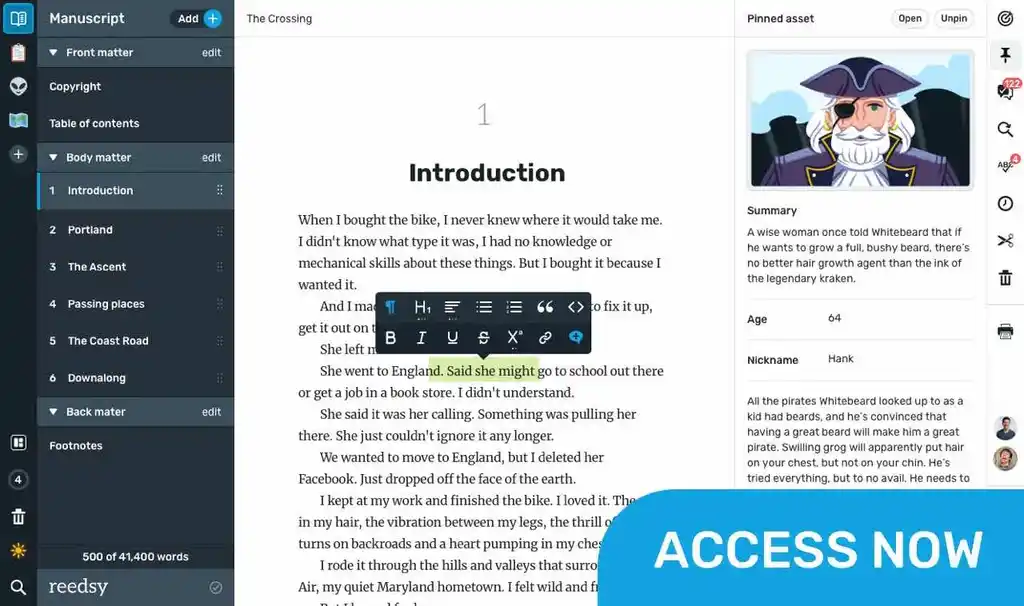Atmosphere in literature is often described as a subtle force or “aura” that makes a book unputdownable. It’s not exactly the same as mood (though they often feed into each other), which relates more to the reader's emotional response to a story — or tone, which reflects the author's attitude (e.g., a sarcastic tone).
Rather, a story’s “atmosphere” refers to an immersive sense of its setting, its stakes, and/or its characters’ experiences. Though this might sound elusive, this guide will show you exactly how to craft an unforgettable atmosphere of your own. Now, let’s look at how you can build atmosphere with these six techniques.
1. Use genre expectations to your advantage
First off, let’s consider genre: an area where atmospheric expectations are largely pre-established. For instance, horror readers expect an atmosphere of dread; fantasy lovers look for wonder and awe; and those who read thrillers — well, they expect to be thrilled.
Understanding and even “leaning into” these expectations can help you satisfy readers. Here are some popular genres and the accompanying atmospheres that readers will likely expect:
🔪 Horror – Claustrophobic, eerie, and unsettling
😱 Thriller – Urgent, suspenseful, and high-stakes
🔎 Mystery – Secretive, puzzling, and tense
♥️ Romance – Tender, emotionally charged, infused with passion or longing
🧝 Fantasy – Magical, whimsical, and epic
Most genre writers will be familiar with these conventions, but it still helps to articulate them, and to think about how your planned story does (or does not) adhere to them. Indeed, though genre expectations can be a useful guide — especially for genre novices — don’t feel like you must stick to these. While many writers lean into their chosen genre, others subvert genre expectations for a unique twist!
For example, you might set a horror story in a sunlit meadow (think Ari Aster’s Midsommar) for an atmosphere that contrasts jarringly with audience expectations. Or you could write something like Angela Carter’s The Bloody Chamber, in which remixed fairytales explore thorny topics like female agency, violence, and sexuality.
In both of these examples, the atmosphere is arguably more effective for being unexpected — perhaps because both fall under the umbrella of horror, in which “unsettling” readers is key.
But atmospheric subversion can work in other genres, too. Think about how popular the cozy mystery genre has become, with its comforting settings and generally likable protagonists. Or consider “low fantasy,” which intentionally contrasts the epic scale of many classic fantasy stories — instead cultivating an atmosphere that feels more gritty and “real.”
In any case, however your atmosphere stacks up to genre expectations, you will also want to…
2. Select a suitable point of view
Be deliberate with how you tell your story — that is, which point of view you use. This POV controls what the reader sees, what they know, and how they experience every up and down. If you reveal too much (or too little), it can completely throw off your atmosphere.
To give a taste of how each POV facilitates a distinct atmosphere, here are a few evergreen options that authors love:
- First person: This POV pulls readers straight into the mind and experiences of the narrator, making it useful for more raw and “intense” atmospheres. For example, in Barbara Kingsolver’s Demon Copperhead, our narrator is Damon: a poor child growing up in Appalachia. Through his vivid descriptions and distinctive voice, Damon makes the reader feel each triumph and loss as if it were their own.
- Third person limited: A third-person limited POV, meanwhile, creates just enough distance for readers to be aware of the “bigger picture” while maintaining a close emotional connection to one central character. Hanya Yanagihara masterfully employs this technique in A Little Life, giving readers space to reflect on protagonist Jude’s troubled psychological journey without losing themselves in it. In this way, Yanagihara fosters an atmosphere that is reflective yet emotionally charged.
- Unreliable narrators and multiperspectival narratives: And of course, unreliable narrators (particularly when a story has more than one!) introduce atmospheric tension that keeps readers questioning reality. For example, in Gillian Flynn's Gone Girl, the shifting perspectives of Nick and Amy — who often contradict each other — yields an atmosphere of suspense and uncertainty.
Writing tip 💡: For inspiration, read widely in your chosen genre, or even on specific themes. See which perspective those authors use to shape their own atmospheres, and which POV would best align with the story you want to tell.
3. Choose your settings with purpose
Just as POV can enhance a particular atmosphere, settings are more than just passive backdrops. As we’ve touched on, the inherent atmosphere of a sun-soaked meadow is going to be very different from a dark, rainy alleyway at midnight.
Once again, subversion is possible here — but for the most part, you’ll want to choose settings that do embody your intended atmosphere. You can do so artfully, so you’re not hitting readers over the head with the setting’s implications.
Let’s look at some examples where setting is deftly used to create atmosphere in literature.
🌧️ Gloomy moors in Wuthering Heights: In Wuthering Heights, the moors reflect the tumultuous relationship between Heathcliff and Cathy. This setting, combined with the pair’s stormy dynamic, contributes to the novel’s dramatic and eerie atmosphere. “There was no moon, and everything beneath lay in misty darkness,” Emily Brontë writes of the moors — a perfect encapsulation of atmosphere by way of setting.
☀️ Sunlit forests in The Lord of The Rings: Meanwhile, in The Lord of the Rings, the magic forests of Middle Earth inspire feelings of joy and wonder. With imagery such as “the boughs are laden with yellow flowers; the floor of the wood is golden, and golden is the roof” (as Legolas describes the woods of Lothlórien), these forests seem designed to create a buoyant atmosphere. This helps Tolkien strike the right atmospheric balance throughout his trilogy, since the Fellowship has plenty of “darker” moments as well.
❄️ The perpetual snowstorm in The Shining: As you can gather from all these examples, weather is a powerful force when it comes to atmosphere. Perhaps nowhere is this truer than in Stephen King’s iconic horror novel, The Shining. “Flakes of snow swirled and danced across the porch,” King writes. “The Overlook faced it as it had for nearly three-quarters of a century, its darkened windows now bearded with snow…” Through this description and others like it, King builds a chilling (no pun intended!) atmosphere of claustrophobia, making the reader feel just as trapped as the characters.
Writing tip 💡: Make sure your settings aren’t just atmospheric — dig deeper to make them feel three-dimensional and real. If you’re writing about a place that really exists, consider visiting so you can describe it more accurately. If you can’t visit, make sure you do thorough research! And if you’re inventing settings for a sci-fi or fantasy story, consider using a worldbuilding template to cover your bases and keep all your setting information in one place.
4. Deploy symbolism through objects
POV and setting are great for atmosphere — but let’s not forget the finer details. In literature and other media, objects are more than just simple props; they can carry symbolic weight and enhance the atmosphere and emotional undertones of a scene. A wilted flower, for instance, could represent waning love, fading hope, time passing… or all of the above.
So what’s the secret ingredient to great symbolism? Intention. You must choose each symbolic object with a clear narrative purpose in order for it to be atmospherically effective. Here are a few tips on how to do that:
- Keep context in mind: Make sure any symbolic object fits naturally into your story’s environment — no symbol-forcing! A good example might be a wedding ring in a romantic drama. This symbol is a natural fit for the story, yet can also have huge significance that affects the atmosphere.
- Layer in meaning: The best symbolic items are multifaceted, with the potential to represent many things as the story unfolds. To continue with the wedding ring example, it could at various points symbolize love, commitment, disillusionment, or irreversibility; it all depends on how it is used.
- Engage the senses: Once again, try to think “sensory” with both settings and symbolism. In a happy proposal scene, a diamond ring might glitter like warm waters under the sun; in another, the wearer might think of how cold and heavy it feels on her hand, contributing to an atmosphere of despair.
Let’s examine The Handmaid’s Tale for an even more concrete example. In this dystopian novel, clothing is a clear symbol of oppression and control. Each handmaid is forced to wear a large red cloak that hides her body and a white cap that narrows her vision:
“Everything except the wings around my face is red: the color of blood, which defines us. The skirt is ankle-length, full, gathered to a flat yoke that extends over the breasts, the sleeves are full. The white wings too are prescribed issue; they are to keep us from seeing, but also from being seen.”

These outfits are blatant symbols of the handmaids’ non-existent human rights. Their only “purpose” in Gilead is to bear children — hence the blood-red color, a dark nod to menses and childbirth — and they are prohibited from holding jobs, choosing their own partners, and even enjoying hobbies. All this obviously contributes to a bleak and oppressive atmosphere… one that is subtly amplified each time a handmaid’s outfit is mentioned.
Writing tip 💡: Introduce an object early in the story and revisit it throughout the narrative. This produces a satisfying sense of continuity and reinforces atmospheric themes. For example, a recurring symbol of decay — like a tree of slowly rotting fruit — could highlight the slow unraveling of a character’s mental state, or the decline of a relationship.
5. Be specific with word choice
If you really want to refine your novel's atmosphere, remember that even something as “small” as word choice can affect it. Using the right language — particularly language that appeals to one or more of the five senses — will allow readers to truly immerse themselves in your story.
To grasp exactly how adjectives and verbs can shape atmosphere, consider the differences in the following descriptions:
🎪 In The Night Circus by Erin Morgenstern, the use of lush, descriptive language like “unseen mysteries dotted with twinkling lights” and “the petals velvet soft against her skin” creates an otherworldly atmosphere that mirrors the magical, liminal space of the circus.
🔫 Whereas in No Country for Old Men by Cormac McCarthy, the sparse, brutal language and fragmented sentences contribute to the novel’s much harsher atmosphere:
“He stood there looking out across the desert. So quiet. Low hum of wind in the wires. High bloodweeds along the road. Wiregrass and sage."
As you can see, precise language is crucial to atmosphere. Though both these examples use sensory descriptions to paint a picture, the resulting pictures — i.e., each story’s atmosphere — could not be more different.
Writing tip 💡: Instead of relying on stale adjectives like “dark” or “creepy,” find fresh ways to describe the atmosphere. Use unusual comparisons (similes or metaphors) and other creative, evocative language to plunge readers into your particular world.
6. Control pacing to shape your atmosphere
Finally, let’s talk about pacing — how quickly or slowly events unfold. In suspenseful stories, fast pacing can build tension, while slower pacing can enhance a sense of foreboding or melancholy. Either way, to control the pacing and atmosphere of your narrative, you might try:
- Short sentences for urgency: When you want to create tension, rapid-fire sentences can mirror the quickening pace of events. In Suzanne Collins’ novel The Hunger Games, Katniss’s quick, direct thoughts reflect her raw panic in the arena:
“The boy slips to the ground. That’s when I see the knife in his back. Yes, the girl from District 2, ten yards away, running toward me…
I’ve seen her throw in training. She never misses. And I’m her next target.”
- Or lengthier sentences to slow things down: Longer and more lyrical prose, on the other hand, can evoke a dream-like atmosphere — or intensify feelings of dread. The first line of Donna Tartt’s The Secret History is a powerful example of this. The long, flowing sentence reflects the characters’ slowly dawning realization (and the reader’s dawning horror at what has happened):
"The snow in the mountains was melting and Bunny had been dead for several weeks before we came to understand the gravity of our situation."
With pacing — as with all the other elements above — a good balance is key. While overlong sentences and excessive description can bog down the plot, a lack of description can leave your atmosphere feeling underdeveloped or even confusing. To that end, the vast majority of stories should alternate between short and long sentences depending on each scene’s pacing needs; striking this balance should keep the atmosphere “in sync” with the natural rhythm of your story.
Keep in mind, of course, that creating atmosphere is a skill that gets better with practice. So read widely, observe how other writers create atmosphere, and apply what you learn to your own work. By carefully considering your settings, symbolism, and pacing, you can conjure an atmosphere that draws readers into your world and keeps them hooked until the very last page.











